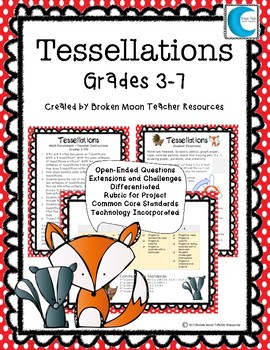Tessellations
Broken Moon Teacher Resources
12 Followers
Grade Levels
3rd - 6th
Subjects
Resource Type
Standards
CCSS3.MD.C.5
CCSS3.MD.D.8
CCSS4.MD.C.7
CCSS4.OA.C.5
CCSS3.G.A.1
Formats Included
- PDF
- Internet Activities
Pages
17 pages
Broken Moon Teacher Resources
12 Followers
Compatible with Digital Devices
The Teacher-Author has indicated that this resource can be used for device-based learning.
Description
Students create and design their very own Tessellations. This project is a complete activity incorporating math, art, real world components, and technology. Included are open-ended questions, extensions and challenges, and differentiation.
Contents:
*Teacher Instructions
*Student Directions
*Step by Step Tessellation Instructions
*Extensions and Challenges
*Student Rubric
*Student Examples
Contents:
*Teacher Instructions
*Student Directions
*Step by Step Tessellation Instructions
*Extensions and Challenges
*Student Rubric
*Student Examples
Total Pages
17 pages
Answer Key
N/A
Teaching Duration
2 Weeks
Last updated Jan 11th, 2018
Report this resource to TPT
Reported resources will be reviewed by our team. Report this resource to let us know if this resource violates TPT’s content guidelines.
Standards
to see state-specific standards (only available in the US).
CCSS3.MD.C.5
Recognize area as an attribute of plane figures and understand concepts of area measurement.
CCSS3.MD.D.8
Solve real world and mathematical problems involving perimeters of polygons, including finding the perimeter given the side lengths, finding an unknown side length, and exhibiting rectangles with the same perimeter and different areas or with the same area and different perimeters.
CCSS4.MD.C.7
Recognize angle measure as additive. When an angle is decomposed into non-overlapping parts, the angle measure of the whole is the sum of the angle measures of the parts. Solve addition and subtraction problems to find unknown angles on a diagram in real world and mathematical problems, e.g., by using an equation with a symbol for the unknown angle measure.
CCSS4.OA.C.5
Generate a number or shape pattern that follows a given rule. Identify apparent features of the pattern that were not explicit in the rule itself. For example, given the rule “Add 3” and the starting number 1, generate terms in the resulting sequence and observe that the terms appear to alternate between odd and even numbers. Explain informally why the numbers will continue to alternate in this way.
CCSS3.G.A.1
Understand that shapes in different categories (e.g., rhombuses, rectangles, and others) may share attributes (e.g., having four sides), and that the shared attributes can define a larger category (e.g., quadrilaterals). Recognize rhombuses, rectangles, and squares as examples of quadrilaterals, and draw examples of quadrilaterals that do not belong to any of these subcategories.





